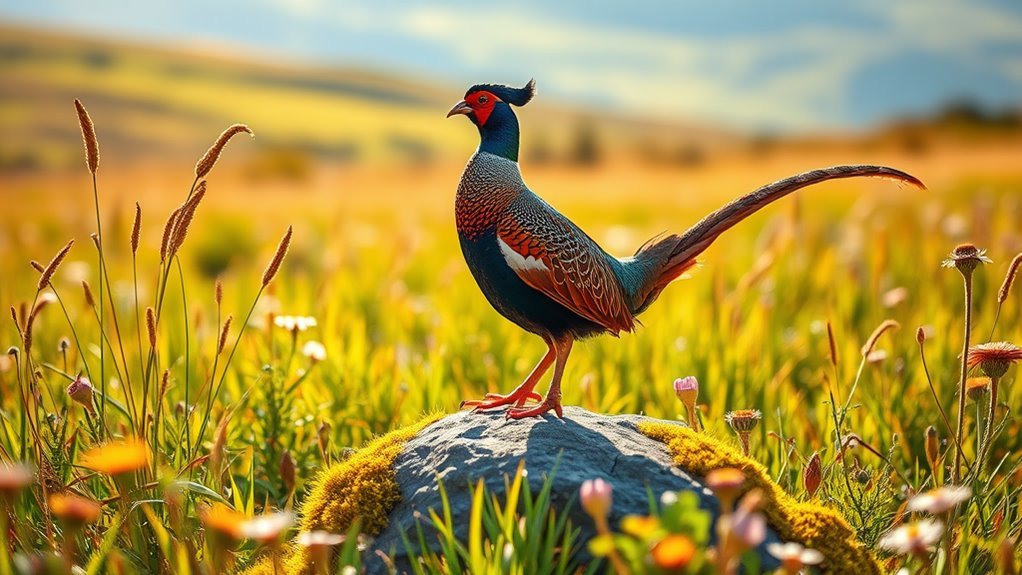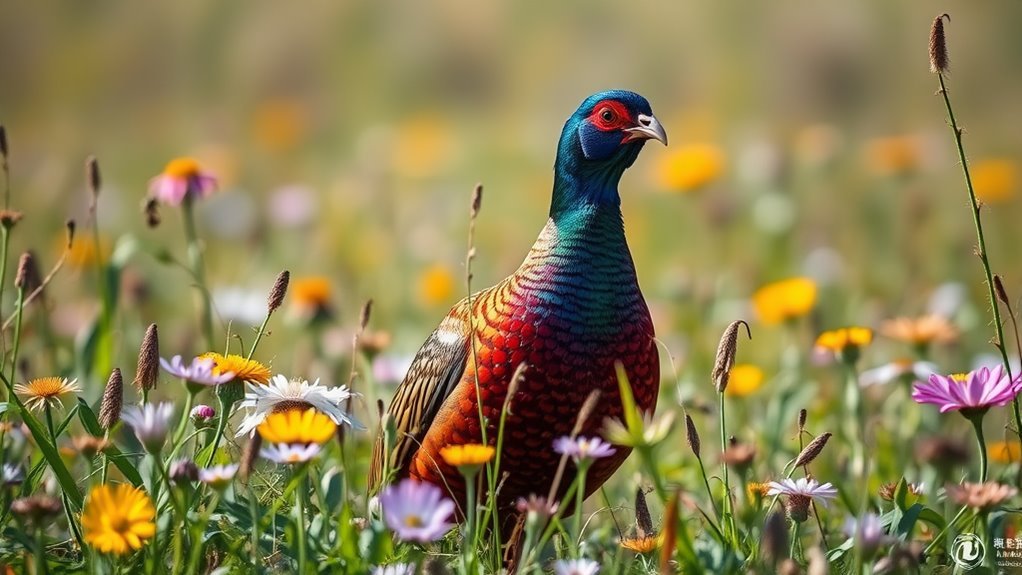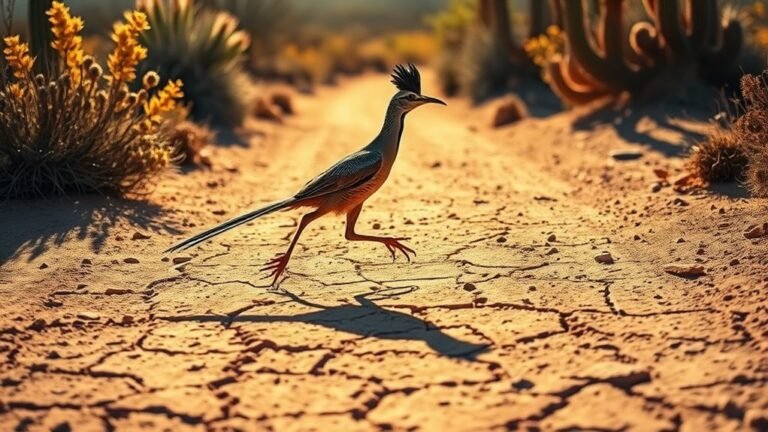Understanding Pheasants: Facts and Features
Pheasants are interesting birds. They live in various habitats and show different behaviors. Their physical features help them blend into their surroundings and attract mates. Their diet changes with the seasons, which helps them survive. As you learn more about these birds, you will see the conservation issues they face today and what this means for their future. Understanding these challenges is important for protecting pheasants and their environments.
Key Takeaways
- Pheasants inhabit diverse ecosystems including grasslands, forests, and agricultural fields, showcasing their adaptability to different environments.
- Their vibrant plumage and long tails serve both camouflage and attraction during courtship rituals, aiding in reproduction.
- Pheasants have a varied omnivorous diet, shifting seasonally from insects to seeds to maintain nutrient intake year-round.
- Males attract females through colorful displays and sounds; females incubate eggs and care for chicks vital for population sustainability.
- Conservation challenges include habitat loss from agriculture and urban development, making local support for habitat restoration essential.
Habitat and Distribution of Pheasants

Pheasants live in many types of habitats, including grasslands, forests, agricultural fields, and wetlands. They show great adaptability, allowing them to thrive in different ecosystems.
These birds prefer areas with plenty of cover and food, which are crucial for their survival and reproduction. They're found in Asia, Europe, and North America, both in their native ranges and in places where they were introduced.
As you learn about these habitats, you can see how pheasants adapt to changes in land use and climate. This information helps us understand their role in the ecosystem and their conservation needs.
Physical Characteristics and Adaptations
Pheasants have unique physical characteristics and adaptations that help them survive in different habitats. These birds exhibit a variety of feather colors.
This bright plumage helps them blend into their surroundings and attract mates. Their long, beautiful tails are also important; they enhance the bird's appearance and help with communication during courtship displays.
Pheasants have strong bodies and legs, which assist them in moving across various terrains. These physical traits enable them to live successfully in diverse environments.
Learning about these features deepens our appreciation of these fascinating birds.
Diet and Feeding Behavior

Pheasants have a varied diet that helps them adapt to their surroundings. They're omnivores and eat a mix of seeds, insects, and small invertebrates. Their eating habits change with the seasons. In warmer weather, they prefer insects for protein. When it gets colder, they focus on seeds and grains. This ability to adjust their diet helps them get the nutrients they need all year round.
Pheasants often forage in groups. Foraging together makes finding food more efficient. It also helps them build social bonds that can improve their chances of survival.
Their flexibility in diet shows their intelligence and resilience. This makes them interesting birds for nature lovers and birdwatchers to learn about and observe.
Mating Rituals and Reproduction
During mating season, male pheasants display colorful feathers and make sounds to attract females. They perform movements that emphasize their physical traits, increasing their chances of being noticed by a female.
When a female shows interest, she moves closer to the male. After courtship, the female starts her nesting process by laying about 10 to 15 eggs in a shallow nest, which she lines with grass and feathers.
She's responsible for incubating the eggs and caring for the chicks. Understanding these behaviors helps to appreciate how pheasants reproduce and the importance of these actions for maintaining their populations.
Role in Ecosystems

Pheasants play an important role in their ecosystems. They contribute to biodiversity and support the health of many habitats.
As prey, they provide food for predators like foxes and hawks. This helps maintain balanced populations of these predators.
Pheasants also help with seed dispersal through their foraging, which promotes plant diversity and growth. These interactions support a thriving ecosystem where many species coexist.
Understanding the role of pheasants highlights how each species sustains life and balances nature.
Conservation Status and Threats
Pheasants are beautiful birds that many people admire for their appearance and hunting appeal. However, they face serious challenges due to their conservation status. Habitat loss is a major threat, caused by expanding agriculture and urban development, which reduces the space they need to thrive.
Climate change also affects their ecosystems, leading to declines in their populations and breeding rates.
To help protect pheasants, effective conservation measures are essential. Implementing hunting regulations ensures that practices remain sustainable, allowing pheasant populations to recover. You can play a role in this effort by supporting local conservation projects and aiding in habitat restoration.
Frequently Asked Questions
How Long Do Pheasants Typically Live in the Wild?
Pheasants typically live for three to five years in the wild. Their lifespan may change based on threats from predators, the availability of food, and environmental conditions. Recognizing these factors helps us understand the challenges pheasants face in their habitats.
What Are Common Predators of Pheasants?
Common predators of pheasants include foxes, hawks, and raccoons. These animals hunt pheasants using stealth and aerial attacks. Pheasants must be vigilant to survive these threats in the wild. They face challenges daily as they navigate their environment while avoiding predators. Understanding these threats can help in efforts to protect pheasant populations.
Can Pheasants Be Kept as Pets?
Keeping pheasants as pets is unusual, but if you want to try, you must provide the right environment and care. They need enough space to move around and socialize for their health and happiness.
How Do Pheasants Communicate With Each Other?
Pheasants communicate using different sounds. These calls help them socialize and interact with each other. By watching these vocalizations, you can learn about their social structures. Understanding their communication is key to appreciating their behavior and dynamics.
What Is the Most Popular Pheasant Species for Hunting?
The ring-necked pheasant is the most popular species for hunting. This bird is known for its colorful plumage and challenging flight patterns, making it a favorite among hunters. Always check local hunting regulations to ensure a safe and legal hunting experience. Enjoy the excitement of the hunt while respecting wildlife and nature.

Hello, I’m Emily Price, the founder of Birds Affection. As a passionate bird enthusiast and spiritual seeker, I’ve always been fascinated by the symbolic meanings and mystical connections between birds and our lives. On this website, I share my knowledge and insights on the spiritual significance of various bird species, exploring their roles as messengers, guides, and teachers. Through my writing, I aim to inspire and educate others on the profound wisdom and beauty that birds bring to our world. Join me on this journey as we delve into the enchanting realm of bird symbolism and discover the hidden meanings behind these magnificent creatures.





